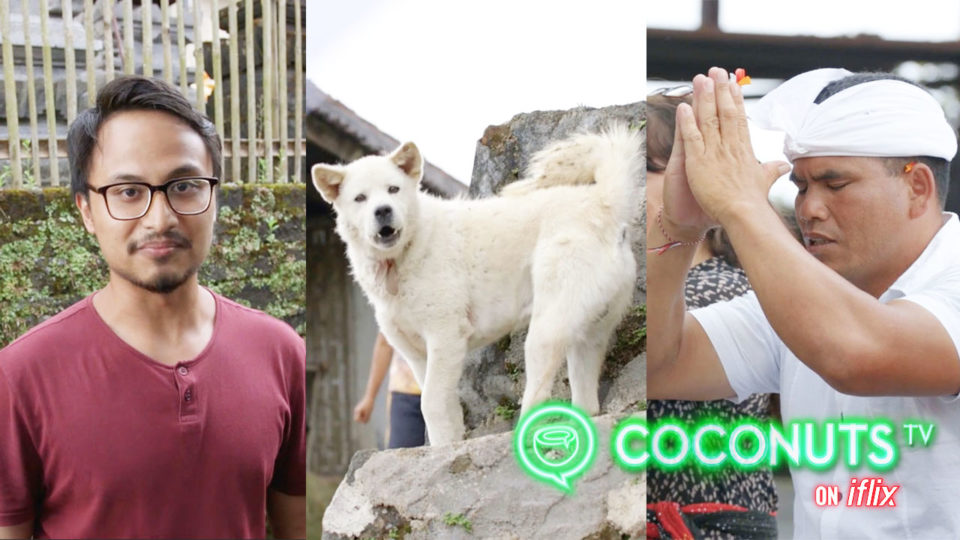PRESENTED BY
Our brand-new documentary series, COCONUTS TV ON IFLIX, the first original docu-series to drop on the streaming service, is out right now! In the episode “Animals and Us,” we touch down in Bali to see how the paradise island’s native breed dogs are living through hell — almost literally — due to an active volcano. Read on to see how selfless animal activists on the island bravely put themselves on the line to help our furry friends survive.
Walking down your average street in Bali, where odds are good you’d see a playful pooch looking towards you with a hopeful wag of their tail, you probably wouldn’t think that the island’s street dogs are under any threat of extinction. But local animal welfare activists believe that Bali dogs may face extinction within the decade due to an outbreak of rabies, government-led cullings, a not-so-underground dog meat trade, and, for several months in 2017, an active volcano.
We touched down to film in Bali in late October, after Mount Agung had already been rumbling for months but hadn’t actually erupted. Nevertheless, the local government evacuated citizens from nearby villages and towns, leaving them void of all human life save for the few who risked their lives to return to their homes from time to time.
An interesting aspect of Bali dogs is that they don’t “belong” to humans in the sense that westerners think about pet ownership. Bali dogs may be loyal to those who provide them food, comfort, and companionship, but they tend to be free roamers by nature — hence their “street dog” cred.
As such, many dogs were perilously left behind inside the area of potential eruption. Roam free they did, deserted villages their oyster, but for months they had little access to what is usually one of their main sources of food: humans.
That’s where the selfless folks at Bali Animal Welfare Association (BAWA) came in. The local non-profit, founded by American Janice Girardi, risked their lives daily to drive up to quarantine zones just so they could feed the deserted dogs — on top of everything else they were already doing for canines on the island such as running shelters and promoting kindness to animals through education programs for young children.
Risking death by volcano ourselves in order to document BAWA’s work, the Coconuts TV film crew went with them on one of their dog feeding trips, somewhat assured that we’d be safe by the activists who didn’t seem worried at all — despite the fact that there was no telling if or when the volcano could erupt.
But it soon dawned on us that in the event of an eruption, it’s unimaginable that anyone could drive down the mountain’s winding roads — much of them narrow, single lane affairs — fast enough to escape volcanic ash or even lava.
We had no choice but to tag along. Yet all our worries were put in on back burner as soon as we actually started feeding the dogs. And believe me, it was all worth it just to see the smiles on their faces (or their wagging tails, to be exact).
Buckets of dog chow (rice mixed with boiled eggs and kibble — Bali dogs aren’t fussy eaters) were stowed on half a dozen cars. We stopped to feed dogs about every 5 minutes throughout our 3-4 hour drive. Janice and her team were familiar with many of the dogs on the route — they knew which were aggressive, which needed protection from other dogs while feeding, and which ones were safe to pet (few were, since the area we went to were rabies-positive zones).
The true fruit of BAWA’s labor is the fact that, despite being abandoned for months, the dogs on our route — of which there were easily over 100 — looked very healthy and active. Not a single dog we saw had withered to bare bones, and they were, by and large, happy.
Perhaps that in itself was the priceless reward that drove Janice and the BAWA crew up the volcano every day for those few, dangerous, rumbling months. We had already left Bali by then, but Mount Agung finally erupted in late November, covering the area we had visited just weeks prior in toxic sulphuric ash.
And the dogs we fed? Janice told me shortly after the eruption that many dogs on the volcano had simply vanished — either they ran downhill or they were killed in the eruption. Sadly, she said it was unlikely that the dogs could’ve outrun toxic ash, meaning the latter possibility was more likely.
In 2015, experts estimated that only 100,000 pure Bali dogs remained on the island, down from 600,000 in 2008. Though the number of dogs killed by the volcano remains unknown, the Bali dog population likely plummeted even further at the end of 2017. It’s no longer necessary for BAWA to drive up the volcano to feed dogs, but their struggle to preserve the species — the oldest pure breed known to man according to a study — continues as they battle even greater man-made threats: ill-advised government sanctioned mass cullings to stop the outbreak of rabies and a dog meat trade that’s still carried out casually in the open in parts of the tourist paradise island.
Watch the Bali Dogs segment below or click here, then watch the full docu-series on iflix.





